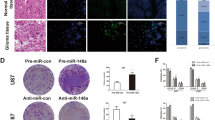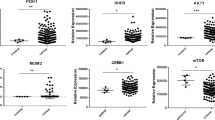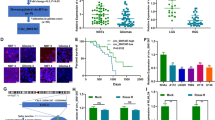Abstract
Aberrant expression of microRNAs (miRNAs) has been implicated in cancer initiation and progression. However, little is known about the potential role of miRNAs in glioma tumorigenesis. In this study, we found that miRNA-106b-5p was significantly upregulated in glioma tumor samples and cell lines compared with normal brain tissues, and its expression level correlated with the pathological grading. Overexpression of miR-106b-5p in glioma tumor cells significantly promoted cell proliferation, although inhibited cell apoptosis in vitro and in vivo. In contrast, knockdown of miR-106b-5p significantly inhibited cell proliferation, although enhanced cell apoptosis. Mechanistic study revealed that two target genes, retinoblastoma-like 1 (RBL1) and RBL2, were involved in miR-106b-5p’s regulation of cell proliferation and one target gene, caspase-8 (CASP8), mediated miR-106b-5p’s regulation of apoptosis. We also investigated the function of the three targets in glioma tumorigenesis by RNA interference manipulation and demonstrated that knockdown of these target genes led to cell proliferation enhancement or cell apoptosis inhibition in vitro. More interestingly, the expression levels of these targets were significantly downregulated in glioma samples and knockdown of these targets in glioma cells inhibited the xenograft tumor formation in vivo. Moreover, we verified the regulation function of miR-106b-5p and its targets on cell proliferation and apoptosis of the primary cultured astrocytes isolated from glioma tumor samples and healthy controls. Collectively, our findings show the critical roles of miR-106b-5p and its targets, RBL1, RBL2 and CASP8, in glioma tumorigenesis and provide potential candidates for malignant glioma therapy.
This is a preview of subscription content, access via your institution
Access options
Subscribe to this journal
Receive 50 print issues and online access
$259.00 per year
only $5.18 per issue
Buy this article
- Purchase on Springer Link
- Instant access to full article PDF
Prices may be subject to local taxes which are calculated during checkout







Similar content being viewed by others
References
Louis DN, Ohgaki H., Wiestler OD, Cavenee WK, Burger PC, Jouvet A . WHO classification of tumours of the central nervous system. Acta Neuropathol 2007; 114: 97–109.
Louis DN . Molecular pathology of malignant gliomas. Annu Rev Pathol 2006; 1: 97–117.
Wen PY, Kesari S . Malignant gliomas in adults. N Engl J Med 2008; 359: 492–507.
Bushati N, Cohen SM . MicroRNA functions. Annu Rev Cell Dev Biol 2007; 23: 175–205.
Lu J, Getz G, Miska EA, Alvarez-Saavedra E, Lamb J, Peck D et al. MicroRNA expression profiles classify human cancers. Nature 2005; 435: 834–838.
Zhang Y, Dutta A, Abounader R . The role of microRNAs in glioma initiation and progression. Front Biosci 2012; 17: 700–712.
Cai K, Wang Y, Bao X . MiR-106b promotes cell proliferation via targeting RB in laryngeal carcinoma. J Exp Clin Cancer Res 2011; 30: 73.
Li B, Shi XB, Nori D, Chao CK, Chen AM, Valicenti R et al. Down-regulation of microRNA 106b is involved in p21-mediated cell cycle arrest in response to radiation in prostate cancer cells. Prostate 2011; 71: 567–574.
Li Y, Tan W, Neo TW, Aung MO, Wasser S, Lim SG et al. Role of the miR-106b-25 microRNA cluster in hepatocellular carcinoma. Cancer Sci 2009; 100: 1234–1242.
Petrocca F, Visone R, Onelli MR, Shah MH, Nicoloso MS, de Martino I et al. E2F1-regulated microRNAs impair TGFbeta-dependent cell-cycle arrest and apoptosis in gastric cancer. Cancer Cell 2008; 13: 272–286.
Smith AL, Iwanaga R, Drasin DJ, Micalizzi DS, Vartuli RL, Tan AC et al. The miR-106b-25 cluster targets Smad7, activates TGF-beta signaling, and induces EMT and tumor initiating cell characteristics downstream of Six1 in human breast cancer. Oncogene 2012; 31: 5162–5171.
Malzkorn B, Wolter M, Liesenberg F, Grzendowski M, Stuhler K, Meyer HE et al. Identification and functional characterization of microRNAs involved in the malignant progression of gliomas. Brain Pathol 2010; 20: 539–550.
Bogler O, Mikkelsen T . Angiogenesis and apoptosis in glioma: two arenas for promising new therapies. J Cell Biochem 2005; 96: 16–24.
Garcia DM, Baek D, Shin C, Bell GW, Grimson A, Bartel DP . Weak seed-pairing stability and high target-site abundance decrease the proficiency of lsy-6 and other microRNAs. Nat Struct Mol Biol 2011; 18: 1139–1146.
Reczko M, Maragkakis M, Alexiou P, Grosse I, Hatzigeorgiou AG . Functional microRNA targets in protein coding sequences. Bioinformatics 2012; 28: 771–776.
Wang X . miRDB: a microRNA target prediction and functional annotation database with a wiki interface. RNA 2008; 14: 1012–1017.
Guo CP, Liu KW, Luo HB, Chen HB, Zheng Y, Sun SN et al. Potent anti-tumor effect generated by a novel human papillomavirus (HPV) antagonist peptide reactivating the pRb/E2F pathway. PLoS One 2011; 6: e17734.
Takahashi K, Kawai T, Kumar H, Sato S, Yonehara S, Akira S . Roles of caspase-8 and caspase-10 in innate immune responses to double-stranded RNA. J Immunol 2006; 176: 4520–4524.
Ambs S, Prueitt RL, Yi M, Hudson RS, Howe TM, Petrocca F et al. Genomic profiling of microRNA and messenger RNA reveals deregulated microRNA expression in prostate cancer. Cancer Res 2008; 68: 6162–6170.
Hu S, Dong TS, Dalal SR, Wu F, Bissonnette M, Kwon JH et al. The microbe-derived short chain fatty acid butyrate targets miRNA-dependent p21 gene expression in human colon cancer. PLoS One 2011; 6: e16221.
Ivanovska I, Ball AS, Diaz RL, Magnus JF, Kibukawa M, Schelter JM et al. MicroRNAs in the miR-106b family regulate p21/CDKN1A and promote cell cycle progression. Mol Cell Biol 2008; 28: 2167–2174.
Kan T, Sato F, Ito T, Matsumura N, David S, Cheng Y et al. The miR-106b-25 polycistron, activated by genomic amplification, functions as an oncogene by suppressing p21 and Bim. Gastroenterology 2009; 136: 1689–1700.
Wang H, Liu J, Zong Y, Xu Y, Deng W, Zhu H et al. miR-106b aberrantly expressed in a double transgenic mouse model for Alzheimer's disease targets TGF-beta type II receptor. Brain Res 2010; 1357: 166–174.
Hudson RS, Yi M, Esposito D, Glynn SA, Starks AM, Yang Y et al. MicroRNA-106b-25 cluster expression is associated with early disease recurrence and targets caspase-7 and focal adhesion in human prostate cancer. Oncogene 2012; 32: 4139–4147.
Wu H, Wang F, Hu S, Yin C, Li X, Zhao S et al. MiR-20a and miR-106b negatively regulate autophagy induced by leucine deprivation via suppression of ULK1 expression in C2C12 myoblasts. Cell Signal 2012; 24: 2179–2186.
Wang X, Zhang H, Zhang A, Han L, Wang K, Liu R et al. Upregulation of miR-20a and miR-106b is involved in the acquisition of malignancy of pediatric brainstem gliomas. Oncol Rep 2012; 28: 1293–1300.
Trompeter HI, Abbad H, Iwaniuk KM, Hafner M, Renwick N, Tuschl T et al. MicroRNAs MiR-17, MiR-20a, and MiR-106b act in concert to modulate E2F activity on cell cycle arrest during neuronal lineage differentiation of USSC. PLoS One 2011; 6: e16138.
Ashley DM, Riffkin CD, Muscat AM, Knight MJ, Kaye AH, Novak U et al. Caspase 8 is absent or low in many ex vivo gliomas. Cancer 2005; 104: 1487–1496.
Sharif A, Prevot V . Isolation and culture of human astrocytes. Methods Mol Biol 2012; 814: 137–151.
Brummelkamp TR, Bernards R, Agami R . A system for stable expression of short interfering RNAs in mammalian cells. Science 2002; 296: 550–553.
Ebert MS, Neilson JR, Sharp PA . MicroRNA sponges: competitive inhibitors of small RNAs in mammalian cells. Nat Methods 2007; 4: 721–726.
Acknowledgements
This work was supported by the Open Project Program of Jiangsu Province’s Key Discipline/Laboratory of Medicine (KF200971), Key Project of Changzhou Health Bureau (ZD201112).
Author information
Authors and Affiliations
Corresponding authors
Ethics declarations
Competing interests
The authors declare no conflict of interest.
Additional information
Supplementary Information accompanies this paper on the Oncogene website
Supplementary information
Rights and permissions
About this article
Cite this article
Liu, F., Gong, J., Huang, W. et al. MicroRNA-106b-5p boosts glioma tumorigensis by targeting multiple tumor suppressor genes. Oncogene 33, 4813–4822 (2014). https://doi.org/10.1038/onc.2013.428
Received:
Revised:
Accepted:
Published:
Issue Date:
DOI: https://doi.org/10.1038/onc.2013.428
Keywords
This article is cited by
-
Bioinformatic identification and experiment validation reveal 6 hub genes, promising diagnostic and therapeutic targets for Alzheimer’s disease
BMC Medical Genomics (2024)
-
The dysregulation of miRNAs in epilepsy and their regulatory role in inflammation and apoptosis
Functional & Integrative Genomics (2023)
-
Circulating microRNA sequencing revealed miRNome patterns in hematology and oncology patients aiding the prognosis of invasive aspergillosis
Scientific Reports (2022)
-
MiR-106b-5p Promotes Malignant Behaviors of Cervical Squamous Cell Carcinoma Cells by Targeting TIMP2
Reproductive Sciences (2022)
-
RBL1 (p107) functions as tumor suppressor in glioblastoma and small-cell pancreatic neuroendocrine carcinoma in Xenopus tropicalis
Oncogene (2020)



